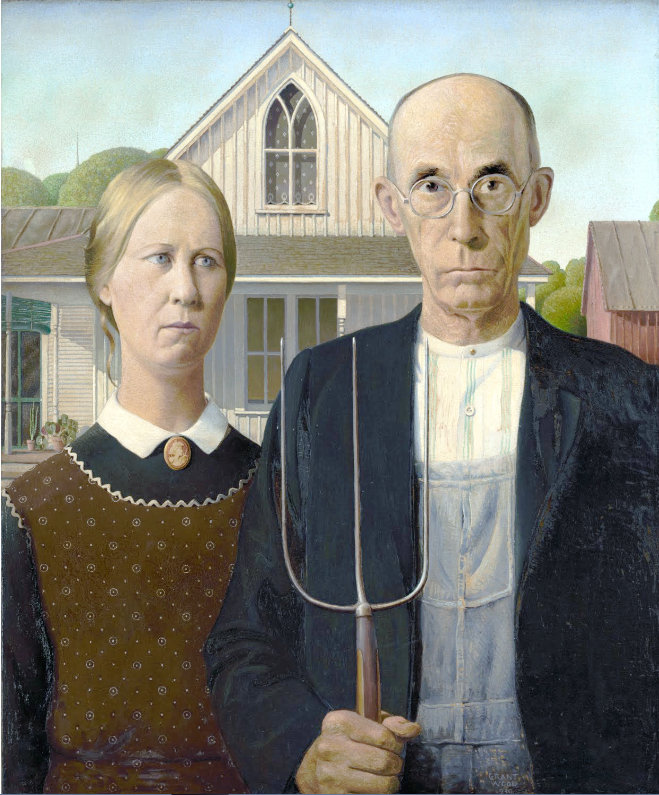Movement in American art that focused on local, representational subject-matter Regionalism was the dominant style in American art during the 1930s and into the 1940s, often depicting scenes of the rural Midwest, American folklore, or the hard times during the Great Depression Thomas Hart Benton, John Steuart Curry, and Grant Wood—all Midwesterners—are artists most commonly associated with Regionalism In some formulations, however, the work of Stuart Davis and Edward Hopper could also be considered ‘Regionalist’, as they painted during the same period and drew on local sources for subject-matter, though in their case the focus was on city life In this light, Regionalism can be viewed as an artist’s desire to connect with his or her surroundings rather than to universal themes (as was often the case with abstraction)
American Regionalism is an American realist modern art movement that included paintings, murals, lithographs, and illustrations depicting realistic scenes of rural and small-town America primarily in the Midwest and Deep South It arose in the 1930s as a response to the Great Depression, and ended in the 1940s due to the end of World War II and a lack of development within the movement It reached its height of popularity from 1930 to 1935, as it was widely appreciated for its reassuring images of the American heartland during the Great Depression Despite major stylistic differences between specific Regionalist artists, Regionalist art in general was in a relatively conservative and traditionalist style that appealed to popular American sensibilities, while strictly opposing the perceived domination of French art
Before World War II, the concept of Modernism was not clearly defined in the context of American art There was also a struggle to define a uniquely American type of art On the path to determining what American art would be, American artists rejected the modern trends emanating from the Armory Show and European influences particularly from the School of Paris By rejecting European abstract styles, American artists chose to adopt academic realism, which depicted American urban and rural scenes Partly due to the Great Depression, Regionalism became one of the dominant art movements in America in the 1930s the other being Social Realism At the time, the United States was still a heavily agricultural nation with a much smaller portion of its population living in industrial cities such as New York City or Chicago
American Scene Painting is an umbrella term for American Regionalism and Social Realism otherwise known as Urban Realism Much of American Scene Painting conveys a sense of nationalism and romanticism in depictions of everyday American life This sense of nationalism stemmed from artists rejection of modern art trends after World War I and the Armory Show During the 1930s, these artists documented and depicted American cities, small towns, and rural landscapes; some did so as a way to return to a simpler time away from industrialization whereas others sought to make a political statement and lent their art to revolutionary and radical causes The works which stress local and small-town themes are often called “American Regionalism”, and those depicting urban scenes, with political and social consciousness are called “Social Realism”
Regionalism limited the spread of abstract art to the East Coast, which allowed American art to gain confidence in itself instead of relying on European styles With American art fully established, Regionalism then was able to bridge the gap between Abstract art and Academic realism similarly to how the Impressionists bridged a gap for the Post-Impressionists, like Paul Cézanne, Vincent van Gogh, and Paul Gauguin, in France a generation earlier Despite the fact the Regionalism developed with the intent of replacing European abstraction with authentic American realism, it became the bridge for American Abstract Expressionism, led ironically by Benton’s pupil Jackson Pollock Jackson Pollock’s power as an artist was mostly due to the encouragement and influence of Thomas Hart Benton
Norman Rockwell and Andrew Wyeth were the primary successors to Regionalism’s natural realism Rockwell became widely popular with his illustrations of the American family in magazines Wyeth on the other hand painted Christina’s World, which competes with Wood’s American Gothic for the title of America’s favorite painting
Regionalism has a strong and lasting influence on popular culture, particularly in America It has given America some of its most iconic pieces of art that symbolize the country Regionalist-type imagery influenced many American children’s book illustrators
